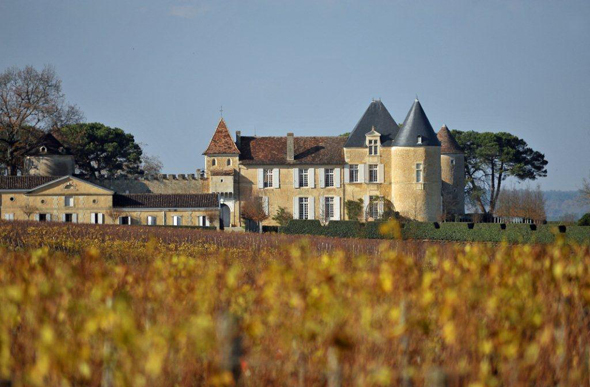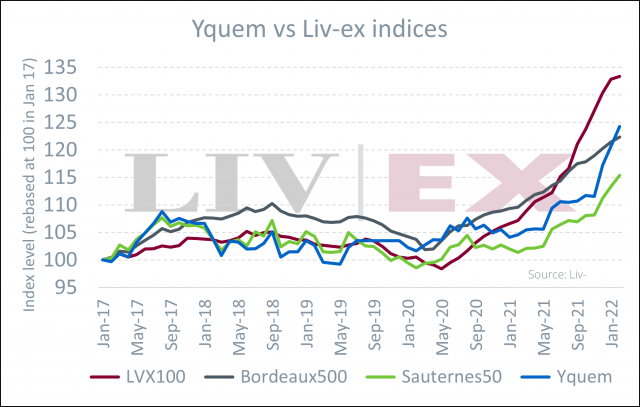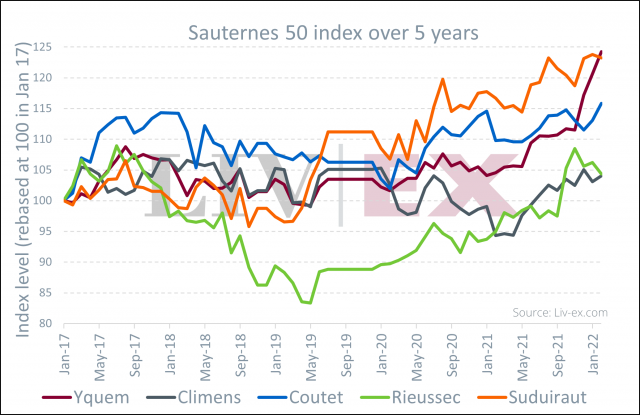This website uses cookies so that we can provide you with the best user experience possible. Cookie information is stored in your browser and performs functions such as recognising you when you return to our website and helping our team to understand which sections of the website you find most interesting and useful.
New March ‘Yquem day’ sees ‘exceptional’ 2019 vintage released
The third Monday of September used to be etched into the calendar of the fine wine world as the annual release date of the last-but-one vintage of Chateau d’Yquem. But from this year, ‘Yquem day’ moves back 6 months to March – the third Tuesday in March to be more precise. Next Wednesday, 22 March 2022 will see Yquem 2019’s much anticipated global release.

The move in release date offers a number of advantages to Chateau d’Yquem. First, it allows a vintage like the exceptional 2019 a little more élevage before it is released; second, it separates the release of Yquem from that of Ygrec, making ‘Yquem day’ more a thing in itself; and, thirdly, it makes Yquem physically available at the same time as the other first growths. Finally, and perhaps most importantly, it allows the Yquem team to travel and promote the new vintage to the trade and to critics alike in the relative calm of the winter months.
And, as with all at LVMH Vins d’exception these days, this has been much thought through and is, in fact, but one part of a wider and more complex strategy. That strategy is not just, nor indeed principally, about timing. Rather more important in fact is the reconsideration of how Yquem is sold and promoted.
I was lucky enough to make my now annual pilgrimage to Yquem in early February. I talked with Mathieu Jullien, LVMH Vins d’exception’s talented Marketing and Sales Director at some length about the strategy before tasting the superb and unique 2019 with Yquem’s President, Pierre Lurton and its brilliant new Estate Manager, Lorenzo Pasquini.
Demystifying Yquem
The new strategy for Yquem comes really in three parts. The first part, as I have already suggested, is largely a question of optimising the timing of the release. It is about shifting the release date to a point in the calendar when the wine-making team can be sure that the vintage to be released will not benefit from a more extended élevage.
But that, in turn, responds to another facet of the strategy which is rather more presentational. The idea here is to change, just a little bit, our pre-conceptions of Yquem and the associated mythology that surrounds this most mythic of wines.
We tend to think of Yquem – or, at least, have tended to think of Yquem – as a wine whose legendarily glacial evolution means that it is practically a crime to drink it young. That impression LVMH Vins d’exception are now keen to change, just a little.
The aim, of course, is not to deny Yquem’s near infinite longevity; but, rather, to re-present it as wine so rare and exceptional in its complexity, balance and harmony (as with this 2019) that it can be enjoyed and appreciated essentially from the moment of its release. And that, of course, makes the timing of the release all the more essential.
The aim, above all, then is to begin to demystify Yquem and, in the process, to turn it from an inaccessible and distant dream (a bottle one might own but that one never quite dares to open) into a precious experience to be shared – and on that is shared. The point is that it is a precondition of sharing that experience that the cork is removed from the bottle! As Mathieu Jullien himself suggests, “more excuses are offered for not opening a bottle of Yquem than any other wine”.
Yquem’s task, then, is to ensure that its wines are not just purchased but consumed. And that, in turn, involves a dual strategy, at least in the first instance.
The first part of that strategy is, and has been, to work with a number of leading wine-themed restaurants and bistros around the world (Michelin-starred and non-Michelin-starred alike) in making Yquem available by the glass from large formats (typically 3 litre double-magnums), in the hope of inspiring a re-encounter and re-experience of the wine.
The second part of the strategy, also ongoing, is the launch of a largely online campaign around the theme of experiencing Yquem ‘at least once in your life’, with the emphasis being very much on the elevation of the moment that the sharing of Yquem allows.
There is, of course, a final element to the strategy that is more strictly commercial. Yquem has, these last few months, been actively traded on la place and beyond, with the result that physical stocks are at the lowest in a long time, prices have firmed up and the creative tension between offer and demand has become more evident with each passing day.
Analysis: establishing the preconditions for a successful release
The results of this are already clear to see. For when Yquem 2019 is released on la place de Bordeaux next week, it is likely to appear on the market at a price point below all previous vintages with equivalent acclaim from the international critics.
If that is correct then two important things follow. Firstly, it will be the first time in a very long time (and certainly since Yquem left the en primeur system) that this can be said. And, second, the logical inference is that the price trajectory from release can only go one way – upwards. That, of course, is likely to prove a massive incentive to the potential purchaser.
The details here are quite interesting. A quick look on wine-searcher.com reveals that if we exclude auction lots, there is no back vintage of Yquem currently available on the secondary market for less than 220 euros in bond per bottle (and only then in very limited quantities for the 2006 and 2008 vintages). And, for a vintage on a rough qualitative par with the 2019, secondary market prices now start at around €270 (for the 2016) and €300 (for the 2015 and 2017).
This is a recent phenomenon, as the more detailed analysis that follows shows.
To understand what has happened, I am grateful once again to Nicola Graham and the team at Liv-ex (The London International Vintners Exchange and the global marketplace for the wine trade) who have helped me prepare the data for the following brief market analysis.
Let’s start with Liv-ex’s Yquem index. This traces the price movement of the last ten physical vintages of Yquem.
Here, for ease of interpretation, it is rescaled at 100 in January 2017 and plotted against Liv-ex’s key indices of fine wine market performance, the LVX100, the Bordeaux500 and, additionally, the Sauternes50.

What this plot shows very clearly is that, until mid-way through 2019, Yquem’s market performance essentially tracked that of the Sauternes50, with both performing worse than either the Bordeaux500 or the LVX100.
Thereafter, they part company. Yquem’s performance on the secondary market starts to pick-up whilst all other indices continue to track downwards. More significantly still, since the moment when the broader fine wine bottomed out in May 2020, it is Yquem which has risen the most.
Yet, crucially, and as the plot again shows well, that rise is most pronounced in the last 3 to 4 months – precisely the period over which Yquem’s new strategy has been put in place by LVMH Vins d’exception. The transformation is complete and it is quite stunning. The Yquem Index is now the best performing of all four of these indices.
That recent transformation is perhaps even more evident if we decompose the Sauternes50 Index and look at the performance of Yquem in comparison to other leading Sauternes and Barsac premiers crus.

Until January 2021, Yquem’s secondary market performance was very much in the middle of the pack; since then, it has been transformed and it is now the best performing label in the Sauternes50, with a staggering and well-sustained upwards trajectory over the last 3-4 months.
As this suggests, the market conditions for the release of Yquem 2019 could scarcely be better aligned; all that now remains to be revealed is the price.
Tasting note
Tasted at Chateau d’Yquem with Pierre Lurton and Lorenzo Pasquini in early February 2022.
Yquem 2019 (55% Sémillon; 45% Sauvignon Blanc; alcohol 14.5%; pH 3.90; residual sugar 138 g/L). This is uniquely brilliant and brilliantly unique – a singular but utterly sublime Yquem. There are two kind of vintage when it comes to Yquem: those in which it is the very best of a closely bunched group of wondrous Sauternes and Barsac and others in which it is in a league and of a class entirely of its own. 2019, like 2015, belongs to the second category of vintages – premier cru supérieur indeed! An incredibly vibrant and energetic wine. It is also fantastically complex. One starts almost to engage in a game of auto-suggestion – any citrus or umami note you can or could ever imagine is discernible here, you just have to conjure the idea in your head and there it is! Indeed, once one tunes into its wavelength it is almost impossible not to be struck by how clearly present and how well expressed each such element is. I wonder how many other vintages of Yquem one can play this game with. The problem, of course, is that this renders rather redundant the convention of listing even the most obvious elements. But the most striking, to me, it seems are saffron, mimosa and clementine, confit lime and white grapefruit, toasted brioche with melted beurre à la fleur de sel, frangipane, verbena, crushed mint leaf, apricot skin and confit ginger. More important is the overall impression: of total harmony, brightness, lift, levity, translucence and clarity. This is sinuous rather than linear; scintillating and pixilated rather than precisely focused per se and staggeringly complex and dynamic. It is also incredibly accessible, with all of its brilliant complexity of youth so evident. The acidity and the sense of crystalline clarity that it brings is captivating too. Very intellectual, even for Yquem and unlike any other Yquem I have ever tasted, at least in part because of the higher proportion of Sauvignon Blanc in the final blend. Pierre Lurton reminds me of Frédéric Dard’s famous comment: “Yquem est la lumière bu”. Indeed. 99.
Related news
A 'challenging yet surprising' vintage for Centre-Loire in 2024

